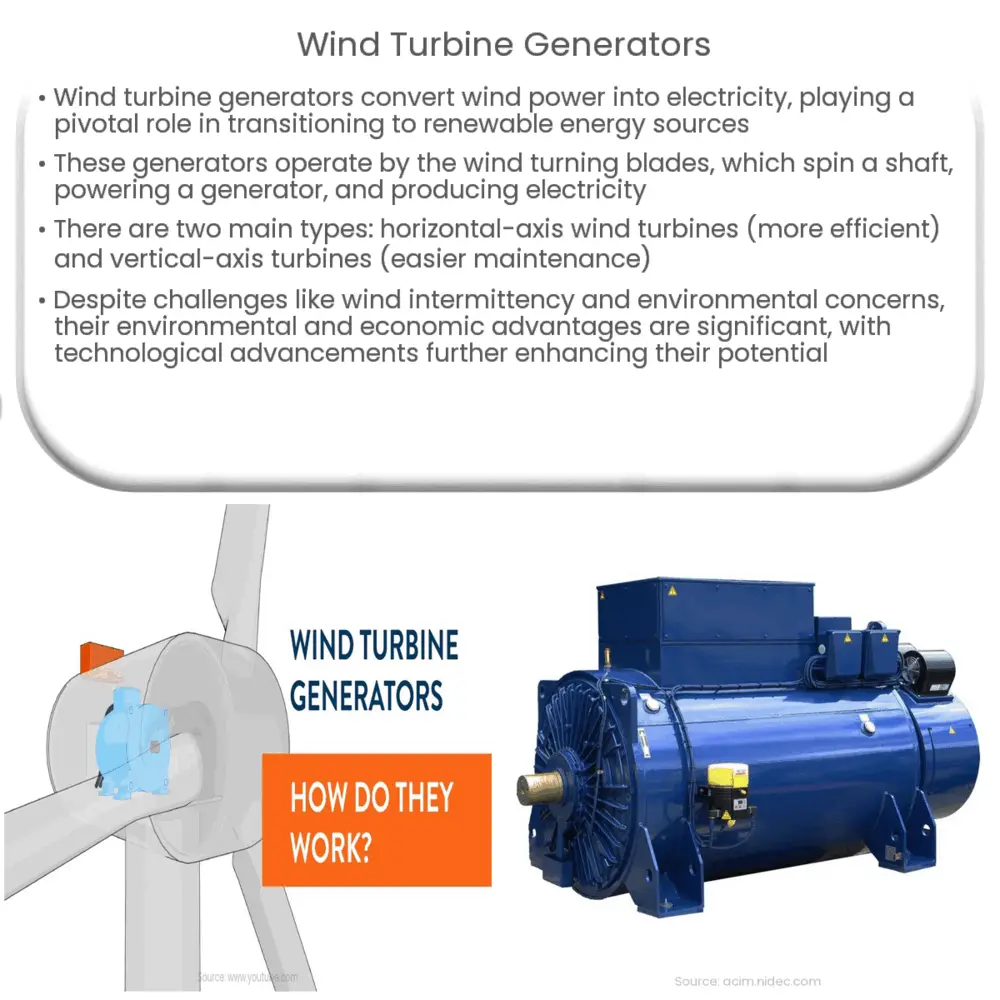Explore the workings, types, and benefits of wind turbine generators along with the challenges and future of wind energy.

Understanding Wind Turbine Generators
Wind turbine generators, often simply referred to as wind turbines, are innovative devices that harness the power of wind and convert it into usable electricity. They are a crucial part of the transition towards clean, renewable energy sources, and their use is steadily increasing worldwide. They offer several benefits including reducing greenhouse gas emissions, enhancing energy security, and contributing to economic growth.
How Wind Turbine Generators Work
The fundamental principle behind wind turbine generators is relatively simple and consists of four primary steps. First, when the wind blows, it applies a force to the turbine blades. This force makes the blades rotate around a rotor, which is connected to the main shaft.
- The wind turns the blades: The kinetic energy from the wind causes the blades of the turbine to spin. The blades are carefully designed to capture as much wind energy as possible.
- The blades spin a shaft: The spinning blades turn a rotor, which is connected to a shaft. This shaft can either be on top of a tower (horizontal-axis wind turbines) or on the side (vertical-axis wind turbines).
- The shaft powers a generator: The shaft is connected to a generator. As the shaft spins, it causes the generator to rotate, which produces electricity.
- Electricity is distributed: The electricity generated is then fed into the electrical grid or stored for later use.
Types of Wind Turbine Generators
There are two primary types of wind turbines: horizontal-axis wind turbines (HAWTs) and vertical-axis wind turbines (VAWTs). Each of these types has its distinct design characteristics, advantages, and disadvantages.
- HAWTs: These are the most common type of wind turbine. They have a horizontal main shaft and the blades face into the wind. HAWTs are generally more efficient at capturing wind energy.
- VAWTs: These turbines have a vertical main shaft, and the generator and gearbox are located at the base of the turbine, making them easier to maintain. However, they are generally less efficient than HAWTs.
Wind Turbine Generators and Renewable Energy
As the global community continues to seek ways to reduce its carbon footprint and mitigate the impacts of climate change, wind turbine generators are becoming increasingly vital in the renewable energy mix. They provide a sustainable way to generate power without emitting harmful greenhouse gases.
Challenges and Future Perspectives
While wind turbine generators offer numerous benefits, they also present certain challenges. These include intermittent wind availability, environmental concerns such as the potential impact on local wildlife, and aesthetic considerations. Advances in technology and improved siting practices are helping to mitigate these issues.
- Intermittency: Wind is an inconsistent source of energy. It does not blow all the time or with consistent speed, which can make energy production unpredictable. This requires efficient storage solutions or alternative sources to balance the grid.
- Environmental Impact: Although wind energy is a green source, wind farms can affect local wildlife, especially birds and bats. Studies and precautions are continuously being taken to minimize these impacts.
- Aesthetic Concerns: Some people find wind turbines visually unappealing. Improved designs and careful siting are being used to address this issue.
Innovation and Technology
Innovations in wind technology are continuously being made, from more efficient designs to smarter predictive maintenance models. One of the key advancements in the field is the development of offshore wind farms. These are located in the sea or in large lakes, which allows them to take advantage of stronger, more consistent winds while also reducing their visual impact on land.
Conclusion
In conclusion, wind turbine generators represent a crucial facet of renewable energy solutions. Despite the challenges they present, their benefits for the environment, energy security, and the economy far outweigh the drawbacks. With ongoing technological innovations, improved policies, and increased public awareness, the role of wind energy is set to become even more prominent in the global energy mix. As we strive towards a sustainable and low-carbon future, wind turbine generators will undoubtedly continue to play a vital role.

